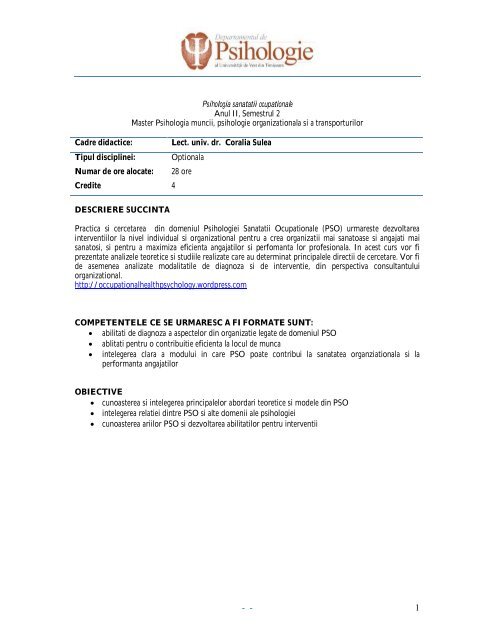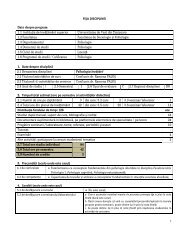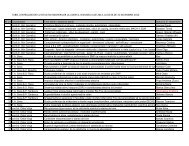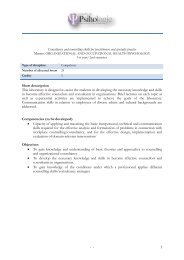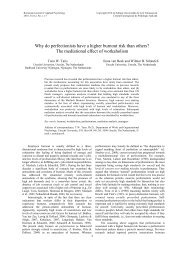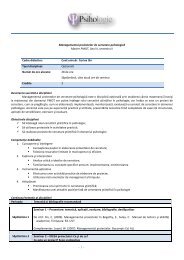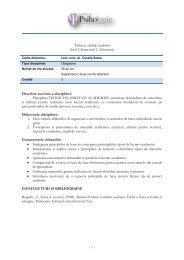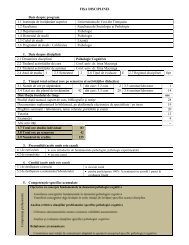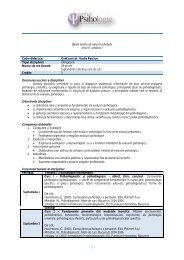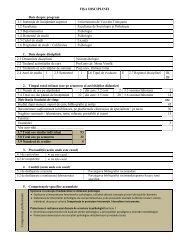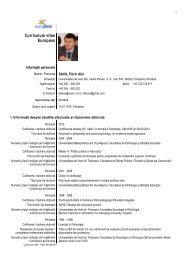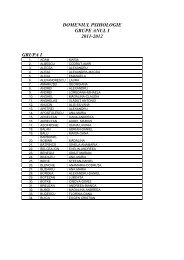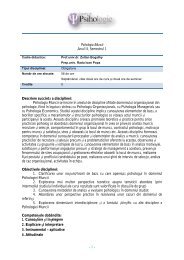Psihologia sanatatii ocupationale - Departamentul de Psihologie al ...
Psihologia sanatatii ocupationale - Departamentul de Psihologie al ...
Psihologia sanatatii ocupationale - Departamentul de Psihologie al ...
- No tags were found...
You also want an ePaper? Increase the reach of your titles
YUMPU automatically turns print PDFs into web optimized ePapers that Google loves.
Cadre didactice:Tipul disciplinei:Numar <strong>de</strong> ore <strong>al</strong>ocate:Credite 4<strong>Psihologia</strong> <strong>sanatatii</strong> <strong>ocupation<strong>al</strong>e</strong>Anul II, Semestrul 2Master <strong>Psihologia</strong> muncii, psihologie organization<strong>al</strong>a si a transporturilorLect. univ. dr. Cor<strong>al</strong>ia SuleaOption<strong>al</strong>a28 oreDESCRIERE SUCCINTAPractica si cercetarea din domeniul <strong>Psihologie</strong>i Sanatatii Ocupation<strong>al</strong>e (PSO) urmareste <strong>de</strong>zvoltareainterventiilor la nivel individu<strong>al</strong> si organization<strong>al</strong> pentru a crea organizatii mai sanatoase si angajati maisanatosi, si pentru a maximiza eficienta angajatilor si perfomanta lor profesion<strong>al</strong>a. In acest curs vor fiprezentate an<strong>al</strong>izele teoretice si studiile re<strong>al</strong>izate care au <strong>de</strong>terminat princip<strong>al</strong>ele directii <strong>de</strong> cercetare. Vor fi<strong>de</strong> asemenea an<strong>al</strong>izate mod<strong>al</strong>itatile <strong>de</strong> diagnoza si <strong>de</strong> interventie, din perspectiva consultantuluiorganization<strong>al</strong>.http://occupation<strong>al</strong>he<strong>al</strong>thpsychology.wordpress.comCOMPETENTELE CE SE URMARESC A FI FORMATE SUNT: abilitati <strong>de</strong> diagnoza a aspectelor din organizatie legate <strong>de</strong> domeniul PSO ablitati pentru o contribuitie eficienta la locul <strong>de</strong> munca intelegerea clara a modului in care PSO poate contribui la sanatatea organziation<strong>al</strong>a si laperformanta angajatilorOBIECTIVE cunoasterea si intelegerea princip<strong>al</strong>elor abordari teoretice si mo<strong>de</strong>le din PSO intelegerea relatiei dintre PSO si <strong>al</strong>te domenii <strong>al</strong>e psihologiei cunoasterea ariilor PSO si <strong>de</strong>zvoltarea abilitatilor pentru interventii- - 1
Continutul tematic <strong>al</strong> cursuluiSaptamana 1Curs 1: INTRODUCERE IN PSIHOLOGIA SANATATII OCUPATIONALEDe citit:Houdmont, J., Leka, S. (2010). Introduction in Occupation<strong>al</strong> He<strong>al</strong>th Psychology. In J. Houdmont and S. Leka(Eds). Occupation<strong>al</strong> He<strong>al</strong>th Psychology (pp.1-31). Chichester: Blackwell PublishingVîrgă, D., Sulea, C., Albulescu, P. (2010). <strong>Psihologia</strong> sănătăţii ocupaţion<strong>al</strong>e: implicaţii teoretice, metodologice şipractice. În A.V. Ciurea, C. L. Cooper şi E. Avram (eds.). Managementul sistemelor şi organizaţiilor sănătăţii (pp. 315-338). Bucureşti: Editura Universitară „Carol Davila”.Vîrgă, D., Zaborilă, C., Sulea, C. (2008). Starea <strong>de</strong> bine în organizaţii. În E. Avram şi C. Cooper (coord.)Tendinţe actu<strong>al</strong>e în <strong>Psihologia</strong> Organizaţion<strong>al</strong>-Manageri<strong>al</strong>ă (pp. 343-370) Iaşi: Polirom.Saptamana 2Curs 2 : TEORII SI MODELE IN PSODe cititBakker, A.B., & Demerouti, E. (2007). The Job Demands-Resources mo<strong>de</strong>l: State of the art. Journ<strong>al</strong> ofManageri<strong>al</strong> Psychology, 22, 309-328Mark, G.M., Smith, A.P. (2008). Stress mo<strong>de</strong>ls: A review and suggested new direction. In J. Hudmont and S.Leka (eds.) Occupation<strong>al</strong> He<strong>al</strong>th Psychology. European Perspectives on research, education and practice (pp. 111-144).Notthingam University Press.Bibliografie complementaraBoyd, C.M., Bakker, A.B., Pignata, S., Winefield, A.H., Gillespie, N., & Stough, C. (2011). A longitudin<strong>al</strong> test ofthe Job Demands–Resources mo<strong>de</strong>l among Austr<strong>al</strong>ian university aca<strong>de</strong>mics. Applied Psychology: AnInternation<strong>al</strong> Review, 60, 112-140Cotton, P., Hart, P.M. (2003). Occupation<strong>al</strong> well-being and performance. A review of organization<strong>al</strong> he<strong>al</strong>thresearch. Austr<strong>al</strong>ian Psychologist. 38 (2), 118-127Hobfoll, S.E. (1989). Conservation of resources: A new attempt at conceptu<strong>al</strong>izing stress, American Psychologist,44, 513-524.Saptamana 3Curs 3 : RELATIA MUNCA-FAMILIE IN PERSPECTIVA PSODe cititSulea, C., Virga, D., G<strong>al</strong>ben, N. (2010). Sc<strong>al</strong>a Conflict Muncă-Familie: An<strong>al</strong>iza proprietăţilor psihometrice <strong>al</strong>eversiunii în limba română. <strong>Psihologia</strong> Resurselor Umane, 2, 10-20Geurts, S.A.E., Demerouti, E. (2003). Work/non work interference. A review of theory and findings. InM.J. Schabracq, J.A.M. Winnubst and C.L. Cooper (eds.) The handbook of work and he<strong>al</strong>th psychology (pp. 279-312). Chichester: John Wiley and sons.Bibliografie complementaraProost, K., De Witte, H., De Witte, K., Schreurs, B. (2010). Work-family conflict and facilitation: Thecombined influence of the job-<strong>de</strong>mand control mo<strong>de</strong>l and achievement striving. European Journ<strong>al</strong> of Work andOrganization<strong>al</strong> Psychology, 19 (5), 615-628Wayne, J.H., Grzywacz, J.G., Carlson, D.S., Kacmar, C. (2007). Work-family facilitation: A theoretic<strong>al</strong>explanation and mo<strong>de</strong>l of primary antece<strong>de</strong>nts and consequences. Human Resource Management Review, 17, 63-76.- - 2
Saptamana 4Curs 4 : ANALIZA DIFERENTELOR INDIVIDUALEDe cititSemmer, N.K. (2003). Individu<strong>al</strong> differences, work stress and heath. In M.J. Schabracq, J.A.M. Winnubstand C.L. Cooper (eds.) The handbook of work and he<strong>al</strong>th psychology (pp. 83-120). Chichester: John Wiley and sonsBibliografie complementaraHeuvel, M. Van <strong>de</strong>n, Demerouti, E., Schaufeli, W.B., Bakker, A. (2010). Person<strong>al</strong> resources and workengagement in the face of change. In J. Houdmont and S. Leka (Eds). Contemporaray Occupation<strong>al</strong> He<strong>al</strong>thPsychology. Glob<strong>al</strong> perspectives on research and practice. (pp.124-150). Chichester: John Wiley and Sons.Saptamana 5Curs 5: PROMOVAREA ATITUDINILOR SI COMPORTAMENTELOR BENEFICE INORGANIZATII : IMPLICAREA IN MUNCA (ENGL. WORK ENGAGEMENT)De cititVîrgă, D., Zaborilă, C., Sulea, C., Maricuţoiu, L. (2009). Adaptarea în limba română a Sc<strong>al</strong>ei Utrecht <strong>de</strong>măsurare a implicării în muncă: examinarea v<strong>al</strong>idităţii şi a fi<strong>de</strong>lităţii. <strong>Psihologia</strong> Resurselor Umane, 7 (1), 58-74.Revistă in<strong>de</strong>xată in baza <strong>de</strong> date PsychInfo.Bakker, A.B., Schaufeli, W.B., Leiter, M.P., & Taris, T.W. (2008). Work engagement: An emerging concept inoccupation<strong>al</strong> he<strong>al</strong>th psychology. Work & Stress, 22, 187-200.Bibliografie complementaraBakker, A.B. (2009). Building engagement in the workplace. In R. J. Burke & C.L. Cooper (Eds.), The peakperforming organization (pp. 50-72). Oxon, UK: Routledge.Saptamana 6Curs 6: IMPLICATII ORGANIZATIONALE SI INDIVIDUALE ALE DEPENDENTEI DEMUNCA (ENGL. WORKAHOLISM)De cititVan Wijhe, C,. Peeters, M.C.W. & Schaufeli, W.B. (2010). Un<strong>de</strong>rstanding and treating workaholism: Setting thestage for successful interventions. In: C Cooper & R. Burke (Eds.)Psychologic<strong>al</strong> and behaviour<strong>al</strong> risks at work.Farnham: Ashgate.Bibliografie complementaraSchaufeli, W.B., Taris, T., & Bakker, A.B. (2006). Dr. Jeckyll or Mr. Hy<strong>de</strong>: On the Differences between workengagement and workaholism. In R. Burke (Ed.), Workaholism in organizationsBakker, A.B., Demerouti, E., & Burke, R. (2009). Workaholism and relationship qu<strong>al</strong>ity: A spillover-crossoverperspective. Journ<strong>al</strong> of Occupation<strong>al</strong> He<strong>al</strong>th Psychology, 14, 23-33Saptamana 7Curs 7 : IMPLICATII ORGANIZATIONALE SI INDIVIDUALE ALE EPUIZARIIPSIHOLOGICE (ENGL. BURNOUT)De cititLe Blanc, P.M., Schaufeli, W.B. (2008). Burnout interventions: An overview and illustration. In: H<strong>al</strong>beslebenJ.R.B. (Eds.), Handbook of Stress and Burnout in He<strong>al</strong>th Care (pp.201-216). New York: Nova Science Publishers.Bibliografie complementaraSchaufeli, W.B., Leiter, M.P. & Maslach, C. (2009). Burnout: 35 years of reseach and practice. Career DevelopmentInternation<strong>al</strong>, 14, 204-220.Bakker, A.B., & Demerouti, E. (2009). The crossover of work engagement between working couples: A closerlook at the role of empathy. Journ<strong>al</strong> of Manageri<strong>al</strong> Psychology, 24, 220-236- - 3
Saptamana 8Curs 8 :GESTIONAREA SOLICITARILOR DE LA LOCUL DE MUNCA SI PROMOVAREARESURSELOR PERSONALE SI ORGANIZATIONALEDe cititGilbreath, B. (2004). Creating he<strong>al</strong>thy workplaces. In C.L. Cooper and I.T. Roberston (eds.) Internation<strong>al</strong>Review of Industri<strong>al</strong> and Organization<strong>al</strong> Psychology (vol 19) (pp. 93-118). Chichester: John Wiley andSons.Bibliografie complementaraGiga, S.I.& Cooper, G.L.(2005). The Development of Psychosoci<strong>al</strong> Capit<strong>al</strong> in Organizations: Implications forWork and Family Life. In Kossek, E.E., Lambert, S.J. (Eds.) Work and Life Integration. Organization<strong>al</strong>,Cultur<strong>al</strong>, and Individu<strong>al</strong> Perspectives, Lawrence ErlbaumGregson, T., Wen<strong>de</strong>ll, J., Aono, J. (1994). Role ambiguity, role conflict, and perceived environment<strong>al</strong>uncertainty: are the sc<strong>al</strong>es measuring separate constructs for accountants? Behavior<strong>al</strong> research in accounting, 6,144-159Saptamana 9Curs 9 : GESTIONAREA COMPORTAMENTELOR CONTRAPRODUCTIVE LA LOCUL DEMUNCADe cititSulea, C. (2008) Comportamentul contraproductiv în organizaţii. În E. Avram şi C. Cooper (coord.) Tendinţeactu<strong>al</strong>e în <strong>Psihologia</strong> Organizaţion<strong>al</strong>-Manageri<strong>al</strong>ă (pp. 615-644). Iaşi: Polirom.Sulea, C., Maricutoiu, L., Zaborila Dumitru, C., Pitariu, H.D. (2010). Predicting counterproductive workbehaviors: a meta-an<strong>al</strong>ysis of their relationship with individu<strong>al</strong> and situation<strong>al</strong> factors. <strong>Psihologia</strong> Resurselor Umane,8 (1), 66-81.Bibliografie complementaraMilam, A. C., Spitzmüller, C., & Penney, L. M. (2009). Investigating individu<strong>al</strong> differences among targets ofworkplace incivility. Journ<strong>al</strong> of Occupation<strong>al</strong> He<strong>al</strong>th Psychology, 14(1), 58-69.Tepper, B.J., Carr, J.C., Breaux, D.M., Gei<strong>de</strong>r, S., Hu, C., Hua, W. (2009). Abusive supervision, intentions toquit, and employees’ workplace <strong>de</strong>viance: A power <strong>de</strong>pen<strong>de</strong>nce an<strong>al</strong>ysis. Organization<strong>al</strong> Behavior and HumanDecision Processes, 109, 156-167.Saptamana 10Curs 10 : ORGANIZATII SANATOASE : ROLUL LIDERULUIDe cititScott, B.A., Colquitt, J.A., Paddock, E.L., Judge, T.A. (2010). A daily investigation of the role of managerempathy on employee well-being. Organization<strong>al</strong> Behavior and Human Decision Processes, 113, 127-140.Bibliografie complementaraW<strong>al</strong>umba, F.O., Wang, P., Wang, H., Schaubroeck, J., Avolio, B.J. (2010). Psychologic<strong>al</strong> processes linkingauthentic lea<strong>de</strong>rship to follower behaviors. The Lea<strong>de</strong>rship Quarterly, 21, 901-914- - 4
Saptamana 11Curs 11 : ORGANIZATII SANATOASE : MANAGEMENTUL RESURSELOR UMANEDe cititWestlan<strong>de</strong>r, G. (1994) Training of psychologists in occupation<strong>al</strong> he<strong>al</strong>th work: Ten years of course<strong>de</strong>velopment- Experience and future perspectives. Eur Work Org Psychology, 4 , 189-202.Bibliografie complementaraGrawitch, M.J., Gottsch<strong>al</strong>k, M., Munz, D.C. (2006). The path to a he<strong>al</strong>thy workplace. A critic<strong>al</strong> reviewlinking he<strong>al</strong>thy workplace practices, employees well-being, and organization<strong>al</strong> improvements. ConsultingPsychology Journ<strong>al</strong>: Practice and Research, 58 (3), 129-147.Saptamana 12Curs 12 : CONSTRUIREA DE POLITICI SI PROGRAME PENTRU ORGANIZATII SANATOASEDe cititTetrick, L.E., Quick, J.C., Quick, J.D. (2005). Prevention perspectives in Occupation<strong>al</strong> He<strong>al</strong>th Psychology. InA.S.G. Antoniou and C.L. Cooper (eds.) Research companion to organization<strong>al</strong> he<strong>al</strong>th psychology (pp. 209-216).Cheltenham: Edward Elgar.Bibliografie complementaraBichard, E. (2009). Creating a He<strong>al</strong>thy Work Environment through Sustainable Practices: Future Ch<strong>al</strong>lenges. InCartwright, S., Cooper, G.,L.,(Eds.). The Oxford Handbook of Organization<strong>al</strong> Well-being.(pp.542-563) OxfordUniversity PressSaptamana 13Curs 13 : TENDINTE ACTUALE IN PSIHOLOGIA SANATATII OCUPATIONALE : PRACTICASI CERCETAREDe cititSinclair, R.R., Sears, L.E., Zajack, Probst, T. (2010). A multilevel mo<strong>de</strong>l of economic stress and employeewell-being. In J. Houdmont and S. Leka (Eds). Contemporaray Occupation<strong>al</strong> He<strong>al</strong>th Psychology. Glob<strong>al</strong> perspectiveson research and practice (pp.1-20). Chichester: John Wiley and Sons.Bibliografie complementaraKompier, M.A.J.& Taris, T. W.(2009) Psychosoci<strong>al</strong> risk factors and work-related stress: state of the art andissues for future research, In Cartwright, S., Cooper, G.,L.,(Eds.). The Oxford Handbook of Organization<strong>al</strong>Wellbeing. Oxford University PressBakker, A.B., & Derks, D. (2010). Positive Occupation<strong>al</strong> He<strong>al</strong>th Psychology. In S. Leka & J. Houdmont(eds.) Occupation<strong>al</strong> he<strong>al</strong>th psychology: A key text. Oxford: Wiley-BlackwellSaptamana 14Curs 14: REALIZAREA PREZENTARILOR DE GRUP- - 5
MODALITATI SI CRITERII DE EVALUARE1. Re<strong>al</strong>izarea unei prezentari <strong>de</strong> grup conform:Maricutoiu, L.P. (2008). Revizuirea literaturii <strong>de</strong> speci<strong>al</strong>itate. In Z. Bogathy si C. Sulea (coord.). Manu<strong>al</strong> <strong>de</strong>tehnici si abilitati aca<strong>de</strong>mice – Editia a doua revazuta si adaugita (pp. 101-109). Timisoara: Editura Universitatii <strong>de</strong>Vest.Sulea, C., Zaborila, C. (2008). Instructiuni pentru re<strong>al</strong>izarea prezentarii la seminar. In Z. Bogathy si C.Sulea (coord.). Manu<strong>al</strong> <strong>de</strong> tehnici si abilitati aca<strong>de</strong>mice – Editia a doua revazuta si adaugita (pp. 71-77). Timisoara:Editura Universitatii <strong>de</strong> Vest.Va fi re<strong>al</strong>izata o prezentare a unui materi<strong>al</strong> <strong>de</strong> sinteza pe tema <strong>al</strong>easa.Se vor urmari urmatoarele aspecte:Partea <strong>de</strong> teorie: <strong>de</strong>finirea clara a conceptelor folosite si prezentarea princip<strong>al</strong>elor teorii explicative<strong>al</strong>e fenomenelor discutate• Partea <strong>de</strong> cercetare: prezentarea aspectelor <strong>de</strong> cercetare din domeniul temei seminarului (prezentareascopului, obiectivelor, ipotezelor, meto<strong>de</strong>i, rezultatelor, limitelor, concluziilor si discutiilor)• Partea aplicativa: prezentarea caracterului aplicativ (in diverse domenii <strong>de</strong> interventie a psihologului,evenimente cotidiene, relatii interperson<strong>al</strong>e)Sarcina este <strong>de</strong> grup. Punctaj: 6 puncte (sarcina obligatorie)Important:• Celor care prezinta li se vor pune intrebari referitoare la intreaga prezentare (nu doar cureferire la partea prezentata <strong>de</strong> fiecare)• Este obligatorie folosirea suportului vizu<strong>al</strong> lizibil pentru facilitarea interactiunii cu cei dinauditoriu• Prezentarea dureaza 20 <strong>de</strong> minute• Prezentarea va respecta cele trei aspecte mentionate mai susVor fi ev<strong>al</strong>uate:• Documentarea prezentarii (concordanta materi<strong>al</strong>elor cu tema seminarului, folosirea <strong>de</strong> materi<strong>al</strong>edin carti sau jurn<strong>al</strong>e <strong>de</strong> speci<strong>al</strong>itate)• Structurarea si claritatea prezentarii• Coerenta prezentarii• Raspunsurile la intrebarile adresate <strong>de</strong> ev<strong>al</strong>uator sau auditoriu• Cunostintele <strong>de</strong> psihologie soci<strong>al</strong>a cu aplicabilitate la tema respectiva2. Citirea critica a unui articol si prezentarea pe scurt a acestuiaSava, F. (2008). Cum sa citesti critic un articol. In Z. Bogathy si C. Sulea (coord.). Manu<strong>al</strong> <strong>de</strong> tehnici siabilitati aca<strong>de</strong>mice – Editia a doua revazuta si adaugita (pp. 89-99). Timisoara: Editura Universitatii <strong>de</strong> Vest.Punctaj: 3 puncte (sarcina option<strong>al</strong>a)1 punct se poate obtine ca urmare a participarii la activitatile <strong>de</strong> cercetare <strong>de</strong>rulate <strong>de</strong> coordonatoruldisciplineiIn restanta, examinarea va presupune: o sinteza a literaturii <strong>de</strong> speci<strong>al</strong>itate pe una dintre temele <strong>de</strong> seminar (folosindu-se 5 sursebibliografice) (6 puncte) (sarcina obligatorie) un materi<strong>al</strong> care sa includa citirea critica a unui articol (3 puncte) (sarcina option<strong>al</strong>a)- - 6


